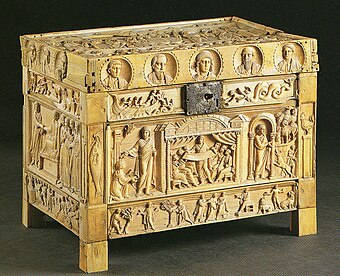
Back Cofre de Brescia Spanish Reliquaire de Brescia French Lipsanoteca di Brescia Italian Lipsanoteca de Brescia Portuguese Skrinja iz Brescie Slovenian

The Brescia Casket, also called the lipsanotheca of Brescia (in Italian lipsanoteca[1]) or reliquary of Brescia, is an ivory box, perhaps a reliquary,[2] from the late 4th century, which is now in the Museo di Santa Giulia at San Salvatore in Brescia, Italy. It is a virtually unique survival of a complete Early Christian ivory box in generally good condition. The 36 subjects depicted on the box represent a wide range of the images found in the evolving Christian art of the period,[3] and their identification has generated a great deal of art-historical discussion, though the high quality of the carving has never been in question. According to one scholar: "despite an abundance of resourceful and often astute exegesis, its date, use, provenance, and meaning remain among the most formidable and enduring enigmas in the study of early Christian art."[4]
The complex iconography of the five faces is illustrated and identified below.
- ^ "Lipsanotheca" is from the Greek λειψανοθήκη, for relic-container.
- ^ It was certainly used as one later and this remains the most likely purpose. See Watson, 290 and 297, note 63. Only Bayens, 6 and elsewhere, suggests that it was a box for alms.
- ^ Watson says 35, Stella 36, but Watson counts the Ananias and Sapphira scenes as two; other sources give different figures, depending how the figures are divided in scenes.
- ^ Mc Grath, 257
© MMXXIII Rich X Search. We shall prevail. All rights reserved. Rich X Search